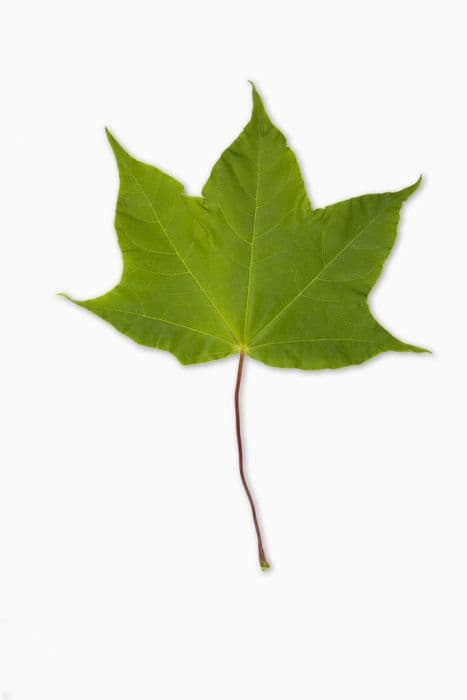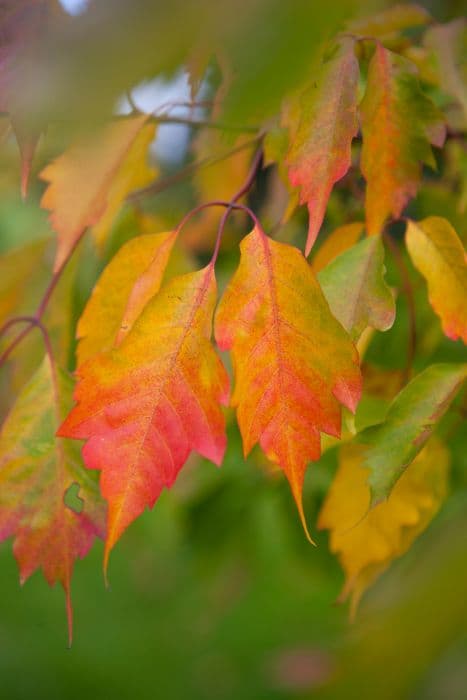Acer rufinerve 'Winter Gold'

ABOUT
The Acer rufinerve 'Winter Gold', commonly known as the winter gold stripe maple, is a striking deciduous tree that is admired for its distinctive bark and vibrant seasonal foliage. Throughout the year, the bark on both the trunk and branches showcases a unique coloration with a blend of green and gold, highlighted by vertical stripes which stand out against the winter landscape when the leaves have fallen. In the colder months, the bark becomes even more pronounced, providing exquisite winter interest. As the seasons change, so does the foliage, beginning with fresh green leaves that unfold in the spring, adding a bright, lively texture to the tree's canopy. Come autumn, these leaves transform into a splendid array of colors, often featuring hues of yellow, orange, and sometimes red, before they eventually fall. The leaves have a classic maple shape, with three or five lobes and a pleated appearance that adds depth and character to the plant's overall aesthetic. The tree also produces small, inconspicuous flowers, which give way to winged seeds that dangle from the branches. These seeds, known as samaras, start out a green color and mature to a tan or brown, adding another element of interest to the tree. The winter gold stripe maple is treasured for its year-round beauty and textural contrast it brings to gardens and landscapes. Without delving into precise dimensions, it is nonetheless important to note that the tree's structure and canopy spread can create a substantial presence, making it an ideal specimen for visual appeal in various outdoor settings.
About this plant
 Names
NamesFamily
Sapindaceae
Synonyms
Japanese Maple, Redvein Maple, Winter Gold Maple
Common names
Acer rufinerve 'Winter Gold'.
 Toxicity
ToxicityTo humans
The plant commonly known as Japanese maple, including Acer rufinerve 'Winter Gold', is not considered toxic to humans. There is no significant evidence that suggests the ingestion of this plant causes poisoning. However, consuming non-food plants is generally not advisable, and if large quantities are ingested there may be a risk of an upset stomach or other digestive discomfort due to the plant material not being intended for human consumption.
To pets
The Japanese maple, which includes the Acer rufinerve 'Winter Gold', is generally considered non-toxic to pets such as dogs and cats. There are no widespread reports of poisoning from these trees in pets. As with humans, non-food plants can still cause gastrointestinal upset if ingested in large quantities, so monitoring pets and preventing them from eating decorative plants is still a good practice.
 Characteristics
CharacteristicsLife cycle
Perennials
Foliage type
Deciduous
Color of leaves
Green
Flower color
Yellow
Height
20-30 feet (6-9 meters)
Spread
15-25 feet (4.5-7.5 meters)
Plant type
Tree
Hardiness zones
5
Native area
Japan
Benefits
 General Benefits
General Benefits- Year-round interest - Has attractive green foliage in spring and summer, golden yellow leaves in fall, and striking green-yellow bark in winter.
- Landscape design versatility - Can be used as a specimen plant, for mass plantings, or as part of a mixed border.
- Wildlife habitat - Provides shelter and food for various species of birds and small mammals.
- Low maintenance - Requires minimal pruning and is generally disease and pest-resistant.
- Drought tolerance - Once established, it can tolerate periods of drought, reducing the need for frequent watering.
- Urban tolerant - Able to withstand pollution and confined soil spaces, making it suitable for urban environments.
- Seasonal color variation - Its leaves, bark, and autumn color provide interesting visual changes throughout the seasons.
- Shade provider - Can offer a cool, shaded area in gardens and outdoor living spaces during the warmer months.
 Medical Properties
Medical PropertiesThis plant is not used for medical purposes.
 Air-purifying Qualities
Air-purifying QualitiesThis plant is not specifically known for air purifying qualities.
 Other Uses
Other Uses- Artistic inspiration: The striking appearance of Acer rufinerve 'Winter Gold', especially its glowing gold and red stems during the winter, makes it a popular subject for photographers and artists who admire the beauty of plants in garden landscapes.
- Natural dyes: The bark and leaves of the plant may be used to create natural dyes for fabrics and wool, providing a range of colors depending on the mordants used in the dyeing process.
- Edible syrup: Although not commonly used for syrup production, with the right knowledge and techniques, a sweet syrup could hypothetically be produced from the sap in a manner similar to that of other maple trees.
- Educational tool: Use in educational settings to teach about seasonal changes in plants, as the Acer rufinerve 'Winter Gold' provides clear visual cues with its winter coloration and summer greenery.
- Craft material: The wood of this maple can be used by woodworkers and crafters to create small wooden items, decorative pieces, or for woodturning projects.
- Landscape design studies: Design students often use this plant as a case study in color theory application and seasonal interest in the landscape, learning how to incorporate plants that offer year-round visual appeal.
- Wildlife shelter: This plant can become a shelter for birds and small mammals during inclement weather, especially in regions with harsh winters where the dense branching provides protection.
- Erosion control: The fibrous root system of Acer rufinerve 'Winter Gold' can help stabilize soil and control erosion on slopes or in areas prone to soil degradation.
- Sound barrier: When planted in rows or groups, this dense and bushy plant can act as a sound barrier, reducing noise from roads or neighbors in residential areas.
- Photography: The distinctive look of the plant across different seasons makes it a gorgeous subject for seasonal photography and could be used to create calendars or themed photo series celebrating the beauty of nature.
Interesting Facts
 Feng Shui
Feng ShuiThe Japanese Maple is not used in Feng Shui practice.
 Zodiac Sign Compitability
Zodiac Sign CompitabilityThe Japanese Maple is not used in astrology practice.
 Plant Symbolism
Plant Symbolism- Resilience: The Acer rufinerve 'Winter Gold', also known as the Snakebark Maple, often symbolizes resilience due to its ability to thrive in various climates and withstand harsh winter conditions.
- Adaptability: Its capability to adapt to different environments makes it a symbol for flexibility and the ability to change and grow in diverse life situations.
- Beauty: With its striking golden-yellow bark that becomes prominent in winter, this plant represents beauty, particularly the kind that stands out during the bleaker seasons of life.
- Growth: As a maple tree, it is commonly associated with growth and longevity, mirroring the expansive life journey and personal development.
- Peace: The serene presence of the Snakebark Maple in a winter landscape evokes a sense of peace and calm, symbolizing tranquility in the face of adversity.
 Water
WaterThe Japanese Maple 'Winter Gold' should be watered thoroughly, allowing the soil to become slightly dry between watering sessions. For a newly planted maple, water every 2 to 3 days with about 2 gallons to help it establish. Mature trees typically need watering once a week, with approximately 10 gallons, depending on the weather conditions and soil type. During the growing season, you may need to increase the frequency to twice a week if there are extended periods of drought or heat. In cooler weather or when the tree is dormant in winter, reduce watering but do not allow the soil to completely dry out.
 Light
LightThe Japanese Maple 'Winter Gold' prefers a location with filtered sunlight or partial shade, especially where it can be protected from harsh afternoon sun. The ideal spot for this tree is where it can get bright, indirect light in the morning with some shelter during the intense midday sun. Too much direct sunlight, especially in hotter climates, can cause leaf scorch, so dappled sunlight is optimal.
 Temperature
TemperatureThe Japanese Maple 'Winter Gold' can tolerate a range of temperatures but thrives best when the temperature stays between 60°F and 80°F. It can survive in temperatures as low as -10°F and as high as 100°F. However, it is essential to protect the tree from harsh winter winds and extreme summer heat to prevent damage.
 Pruning
PruningPrune the Japanese Maple 'Winter Gold' to maintain its shape and to remove any dead or crossed branches. The best time for pruning is late winter or early spring before the tree begins new growth. Light pruning can be done at this time every year, but a more thorough shaping should be done every 2 to 3 years.
 Cleaning
CleaningAs needed
 Soil
SoilWinter Gold Maple flourishes best in a well-draining soil mix with a pH range of 5.5 to 7.5. An ideal soil mix for this plant can be made by blending loamy garden soil, peat moss, and perlite or sand to ensure good drainage and aeration. Regular testing and amending of the soil can help maintain the proper pH and soil structure.
 Repotting
RepottingWinter Gold Maple trees planted in containers may require repotting every 2-3 years to prevent root-bound conditions and replenish nutrients in the soil. Repotting is best done in late winter or early spring before the onset of new growth.
 Humidity & Misting
Humidity & MistingWinter Gold Maple prefers moderate humidity levels, but as an outdoor plant, it is quite adaptable. To ensure optimal growth, try to maintain relative humidity around the plant at 40-60% if possible, although fluctuations will usually be well-tolerated.
 Suitable locations
Suitable locationsIndoor
Provide bright indirect light, cool temps, and well-draining soil.
Outdoor
Plant in partial shade, well-draining soil, mulch roots.
Hardiness zone
5-7 USDA
 Life cycle
Life cycleAcer rufinerve 'Winter Gold', commonly known as Grey-budded snake-bark maple, begins its life as a seed that germinates in spring under proper conditions of moisture and temperature. The seedling emerges and develops into a juvenile sapling, establishing itself with a root system and a stem, while leaves develop to start photosynthesis. As the sapling matures, it grows taller and thicker through the vegetative stage, developing the characteristic green and white striped bark. After several years, it reaches reproductive maturity and starts producing flowers, typically yellowish in spring, followed by the development of winged seed pods (samaras) that disperse with the wind for propagation in late summer to fall. In autumn, the leaves of 'Winter Gold' turn vibrant shades of yellow and red before they are shed in preparation for winter dormancy. This cycle repeats yearly with the tree potentially living for decades, continually growing and contributing to the ecosystem until it reaches the end of its lifespan.
 Propogation
PropogationPropogation time
Early spring
The Japanese maple 'Winter Gold', which is a particular cultivar of Acer rufinerve, is most commonly propagated through grafting. This is a technique that involves attaching a branch or bud from the 'Winter Gold' to the rootstock of another maple, which should be robust and adaptable to varying soil conditions. The best time to graft Japanese maples is in late winter or early spring, just before the sap starts to flow, as this ensures the cuttings are less prone to drying out and the graft can establish before the growing season. Under this method, a scion—the cutting from the 'Winter Gold'—is carefully trimmed to fit into a corresponding cut on the rootstock. The graft site is then bound with grafting tape and sealed with grafting wax to prevent desiccation and disease entry. The scion and rootstock should grow together over the season, eventually forming a strong union and resulting in a new Japanese maple 'Winter Gold' tree.









